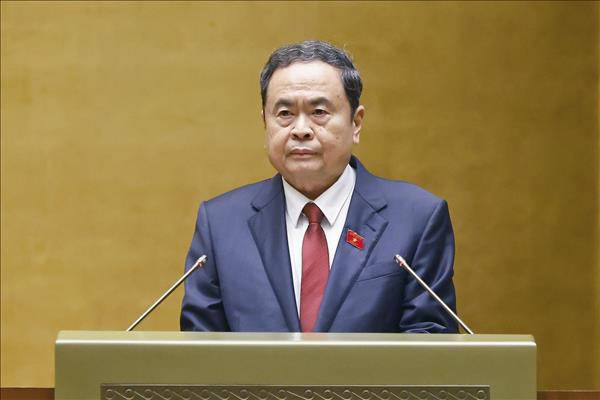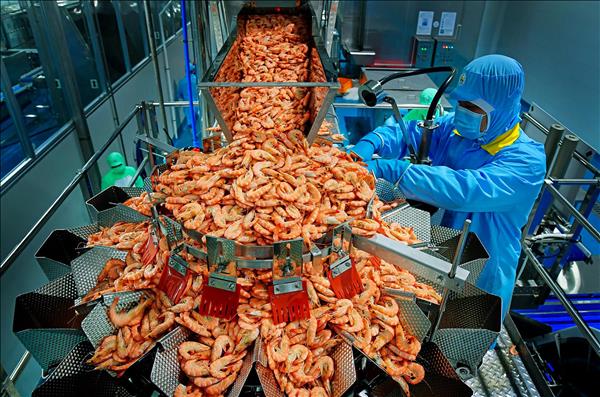The Saint Giong Festival has been evaluated by domestic and foreign researchers as the most unique among the 7,000 traditional folk festivals of Vietnam with special cultural and religious values. For this reason, the festival has been recognized by UNESCO as a world intangible cultural heritage of humanity.
Saint Giong Festival has existed for thousands of years
It is said that in the Dynasty of the 6th Hung King (about 1718-1631 BC), in Giong Village in present-day Phu Dong Commune, Gia Lam District, Hanoi there was a boy who could not speak or smile though he was three years old. Upon hearing the news that the country was in danger of being attacked by the En from the north, he quickly grew up, raised his shoulders and turned into a valiant man. He rode an iron horse and used an iron rod to defeat the invaders. After the victory, he went to the top of Soc Mountain (in present-day Phu Linh Commune, Soc Son District, Hanoi) and flew into the heavens on his horse.
With this sacred feat, people called him “Phu Dong Thien Vuong” and honoured him as one of the “four immortals” or “four genies” (Saint Tan Vien, Saint Giong, Saint Chu Dong Tu and Saint Lieu Hanh) who were worshiped by the Vietnamese people in the Red River delta.
Nowadays, to commemorate his exploits, people in many places in the Red River delta region annually organize the Saint Giong festival with unique rites imbued with the ancient Viet’s cultural imprints. However, the biggest and most special are the Saint Giong festivals in Phu Dong Temple in Phu Dong Commune, Gia Lam District, Hanoi – his birthplace and in Soc Temple in Phu Linh Commune of Soc Son District, Hanoi - the place where he flew into the heavens.
It is said that in the Dynasty of the 6th Hung King (about 1718-1631 BC), in Giong Village in present-day Phu Dong Commune, Gia Lam District, Hanoi there was a boy who could not speak or smile though he was three years old. Upon hearing the news that the country was in danger of being attacked by the En from the north, he quickly grew up, raised his shoulders and turned into a valiant man. He rode an iron horse and used an iron rod to defeat the invaders. After the victory, he went to the top of Soc Mountain (in present-day Phu Linh Commune, Soc Son District, Hanoi) and flew into the heavens on his horse.
With this sacred feat, people called him “Phu Dong Thien Vuong” and honoured him as one of the “four immortals” or “four genies” (Saint Tan Vien, Saint Giong, Saint Chu Dong Tu and Saint Lieu Hanh) who were worshiped by the Vietnamese people in the Red River delta.
Nowadays, to commemorate his exploits, people in many places in the Red River delta region annually organize the Saint Giong festival with unique rites imbued with the ancient Viet’s cultural imprints. However, the biggest and most special are the Saint Giong festivals in Phu Dong Temple in Phu Dong Commune, Gia Lam District, Hanoi – his birthplace and in Soc Temple in Phu Linh Commune of Soc Son District, Hanoi - the place where he flew into the heavens.
 The ceremony of receiving a certificate recognizing the Saint Giong Festival as a World Intangible Cultural Heritage of Humanity. Photo: Tran Thanh Giang 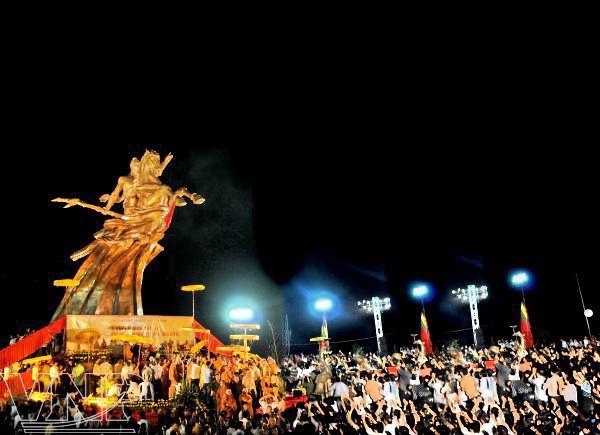 Thousands of people attend the inauguration of Saint Giong statue on the peak of the Soc Mountain in Hanoi. Photo: Tran Thanh Giang 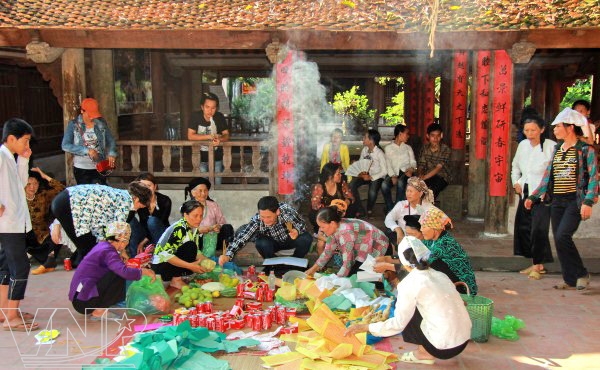 Phu Dong villagers prepare for the Saint Giong Festival. Photo: Trinh Van Bo 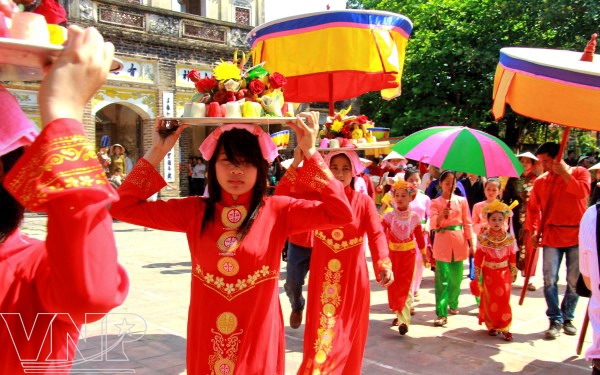 Carrying offerings to the festival. Photo: Trinh Van Bo  A procession of water, which starts the Saint Giong Festival, has the meaning of taking water to clean weapons before the battles and pray for good weather and bumper crops. Photo: Hoang Quang Ha 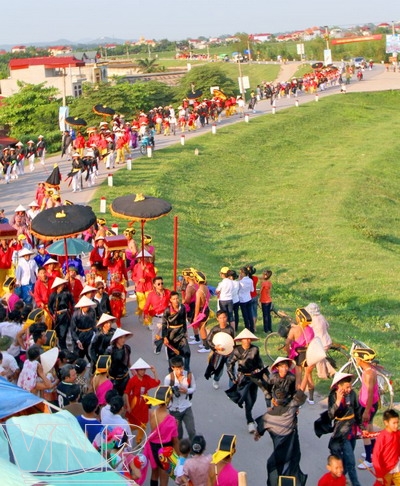 The St. Giong Festival is organized on the banks of the Red River. Photo: Tran Huan |
The Saint Giong festival was held many years ago but it officially became a national festival in the 11th century during the dynasty of King Ly Thai To – the founder of the Ly Dynasty. King Ly Thai To ordered the expansion and upgrade of Phu Dong Temple and created the regulations and forms to organize the Saint Giong festival.
Unlike other folk festivals, apart from praying for good weather, bumper crops and commemorating saints and genies, the Saint Giong festival is considered an interesting “dramatic folk stage” because it attracts the participation of thousands of local people. They perform plays to reenact the battle of Saint Giong. Although the performances are symbolic, they convey a profound philosophy of life. They show the virtues, intelligence, faith and bravery of the general for the fate of the nation; the finial piety; the tolerance of the winner for his rival; and the aspiration for living in a peaceful and happy world.
Over the years, the festival has had a great influence on the cultural and religious consciousness of the Vietnamese people in general and the people in the Red River delta in particular. Therefore, many relics as well as cultural and religious imprints related to Saint Giong are now seen in some rural areas. For example, there are many ancient architectural works with great value, such as communal houses, temples and shrines in the two communes of Phu Dong and Phu Linh. For many years the villagers in these two communes have annually organized the festival on January 6 and April 9 according to the lunar calendar to honour their national hero. The French researcher, G. Dumoutier, was so impressed by the value and jubilant atmosphere of the Saint Giong festival that he wrote in his book, “Revue de l’histoire des religions, Paris 1893”: “The Saint Giong festival, the most moving scene that we have ever seen in the north of Vietnam will live forever in the mind of each viewer. In our ancient Europe if people will feel proud of celebrating a historical event taking place two or three hundreds of years ago.”
The most prominent value of the festival is that it has been preserved and handed down intact from generation to generation. Despite the ups and downs of history and influence by foreign cultures, the Saint Giong festival still keeps its unique features and is not commercialized like other festivals.
Unique Saint Giong Festival
According to researchers, the festival in Soc Temple seems to be a praying for crops festival seen in most spring festivals in the northern plain and the midland regions. The festival in Phu Dong Temple in Gia Lam, Hanoi is seen as a traditional cultural festival reenacting authentically the happenings of the battle of Saint Giong.
Recently, on April 9, 2011 of the lunar calendar, villagers in Phu Dong Commune organized a Saint Giong festival. It was the first one since the festival was recognized by UNESCO. The festival reenacted many dramatic folk performances that helped viewers understand more about the glorious moments of history.
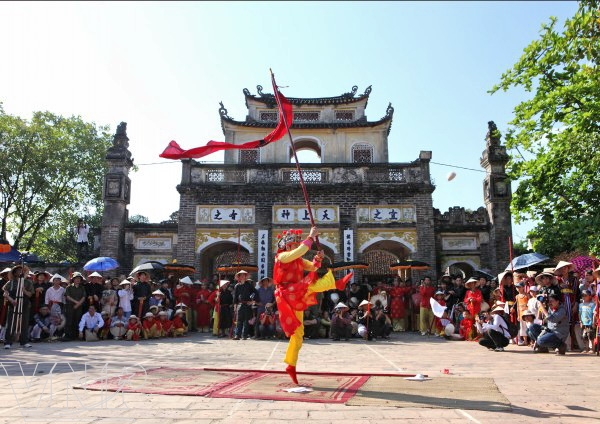 The bowl-kicking performance shows the strength of “leveling the mountains and hills” of Saint Giong. Photo: Hoang Quang Ha 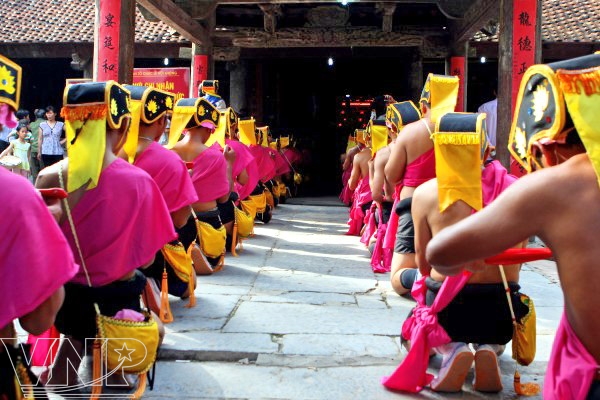 Reenacting a ceremony before the troops go into battle. Photo: Tran Huan  Tens of thousands of people watch the villagers’ performance of hunting a tiger to show the strength of Saint Giong’s troops. Photo: Hoang Quang Ha  The “Drum-signaling man” portraying symbolizing a general of Saint Giong. Photo: Hoang Quang Ha 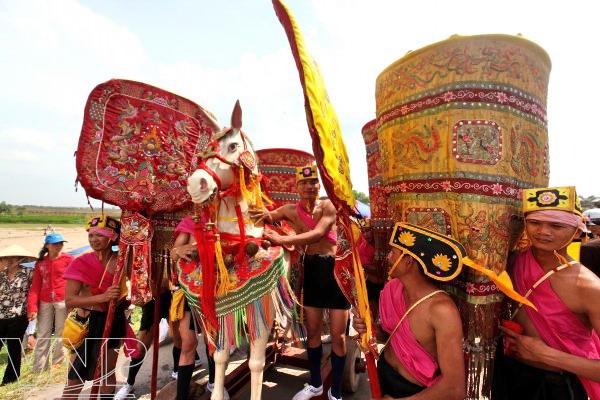 A wooden horse takes the place of the iron horse ridden by Saint Giong. Photo: Hoang Quang Ha 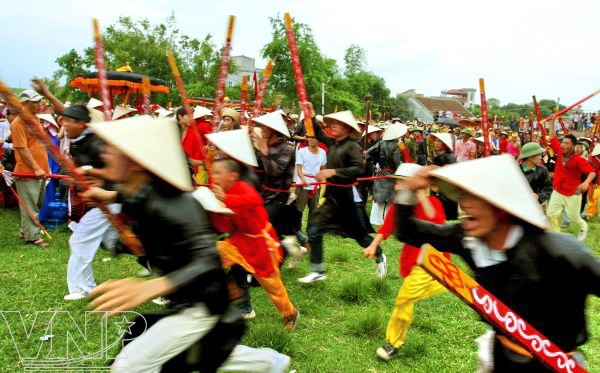 The image of Saint Giong’s troops fighting bravely to defeat the invaders. Photo: Tran Huan 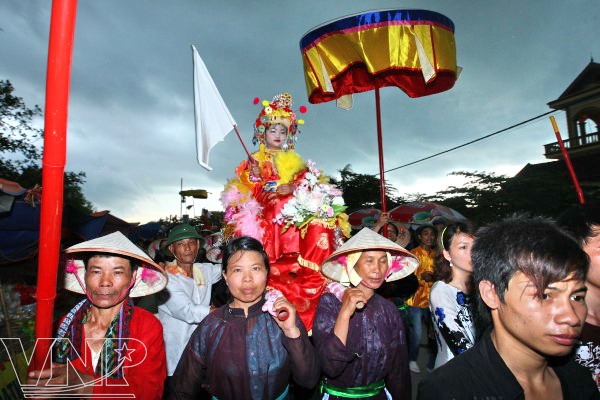 The image of an enemy general surrendering with a white flag in his hand. Photo: Hoang Quang Ha 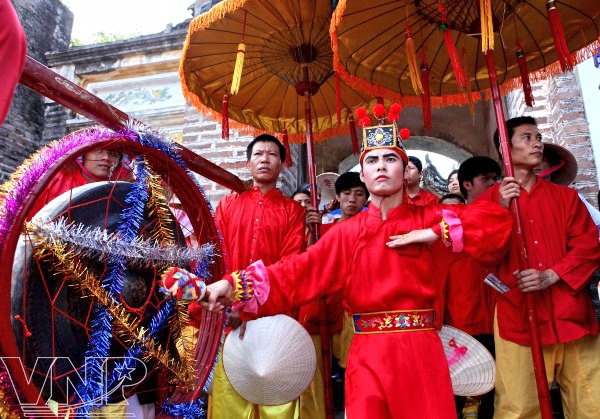 The “Gong-signaling man”, a general, beats the gong to order the triumphal troops to retreat. Photo: Tran Thanh Giang 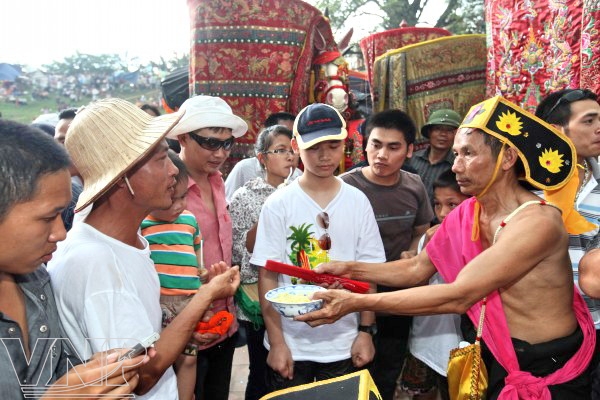 Troops deliver the Saint’s gifts to festival visitors. Photo: Hoang Quang Ha 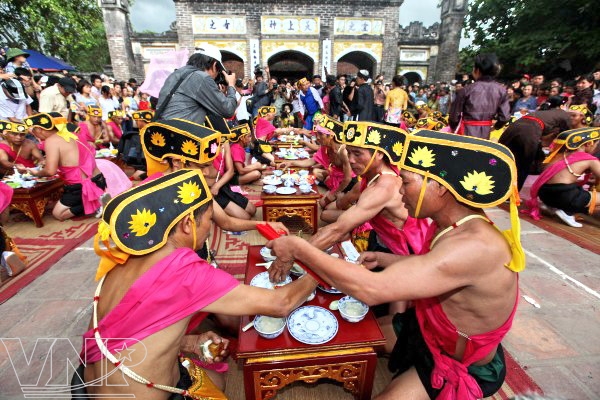 A feast for the troops to celebrate their victory. Photo: Hoang Quang Ha  Saint Giong Festival is considered a “dramatic folk stage” because tens of thousands of local people take part. Photo: Tran Huan |
On April 6, the villagers carried out the ceremony of taking water, which started the festival to clean weapons before the battle and pray for good weather and bumper crops.
At 10am on April 7, a procession of trays of vegetarian food, including rice and salted egg-plant, was held to recreate the tale of the villagers who contributed food to Saint Giong.
The main festival day was on April 9 with a performance called “Phu gia” of Saint Giong’s troops. The troops consist of 120 men about 18-36 years old. They were divided into 6 armies marching back and forth in step, showing the image of a disciplined and warlike army.
At 11am, the Ai Lao troupe performed the hunting of tiger in front of Phu Dong Temple. Before starting the game, about 20 participants performed beautiful and flexible dances to the drumbeat and sound of gongs and then carried out a worshipping ceremony. The game was over when the tiger was captured. Then, many other interesting games and tales of fighting of Saint Giong’s troops were reenacted until the afternoon. After the victory, a feast was given to the troops. During the evening, cultural activities were held such as a fireworks display, a Tuong performance and folk games to celebrate the victory. The festival lasted until April 12.
Through tales with the image of Saint Giong’s troops defeating the En invaders, the image of soldiers saying goodbye to their mother before going to battle, the image of a victorious army returning to the homeland and the image of surrendering invaders, the Saint Giong Festival helped viewers learn about legends related to Saint Thanh Giong. It is not only a religious, folk and cultural activity but also a “great drama” depicting a great moment in history, culture, religion and art. It is also a profound philosophy of the struggle for life and preserving the nation as well as showing the moral standards of humans in war or peace.
For the above reasons, the Saint Giong Festival is immortal and is worthy to be honoured. At 6pm (10:20 pm in Vietnam) on November 16, 2011 in Nairobi, Kenya, the Saint Giong festival in Phu Dong Temple and Soc Temple in Hanoi was officially recognized as a world intangible cultural heritage of humanity by UNESCO.
Story: Thao Vy - Photos: Hoang Quang Ha – Tran Thanh Giang – Tran Huan – Trinh Van Bo



